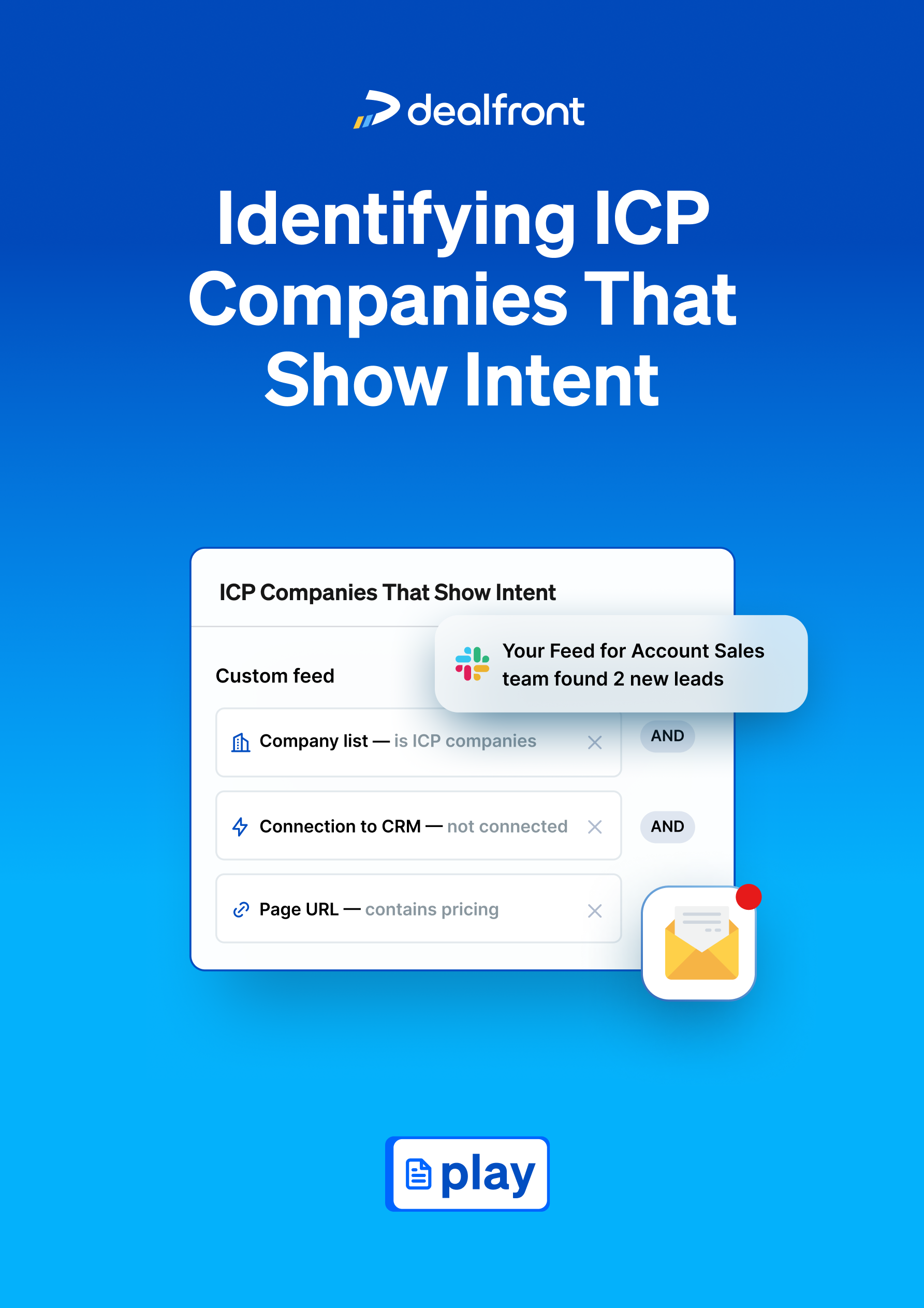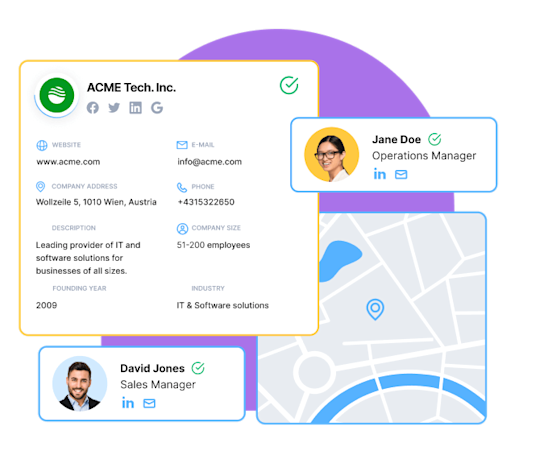60-Second Summary
Visitor tracking has moved beyond simple company identification — it's now a core engine for pipeline generation. As organizations look for alternatives to tools like Snitcher, the focus is on deeper data, better integrations, and scalable insights.
Key insight: The real value in visitor tracking lies in connecting intent data, ICP fit, and CRM integrations to drive qualified pipeline — not just generate lead lists.
Standout strategy: Leadfeeder by Dealfront shines by blending real-time company identification with GDPR-compliant data, strong European coverage, and seamless CRM/marketing integrations.
Real-world lesson: Many teams leave value on the table by relying on disconnected tools — the strongest ROI comes from platforms that unify sales and marketing workflows through smart data flow.
Framework to follow: Evaluate tracking tools using criteria like match rate accuracy, real-time intent filtering, and integration quality — not only by cost or features in isolation.
With the realization that web visitor tracking is essential for understanding and converting website interest into real pipeline, there are more visitor tracking and pipeline generation tools cropping up than ever, each offering its own mix of data, analytics, and integrations. The challenge now isn’t finding a tool; it’s finding the right one for your business model, budget, and existing tech stack.
But not every solution works the same way; some focus purely on identifying the company behind a website visit, while others go further, combining behavioral data, firmographic enrichment, and intent signals to give a full picture of your audience’s journey. That difference can determine whether your team gets names on a list or qualified opportunities in the pipeline.
According to Bain’s 2025 research, 70% of companies report difficulty integrating their sales plays into CRM and revenue technologies. This is a telling sign that many revenue teams haven’t yet unlocked the full potential of connected data. And that’s why teams today aren’t just looking for a visitor tracking tool, they’re looking for a platform that fuels pipeline generation across sales and marketing alike.
Why look for Snitcher alternatives
Many organizations start exploring alternatives to Snitcher when they hit the limits of what the tool can do for modern revenue workflows. Some teams find the pricing structure doesn’t scale with their business growth or doesn’t align with the return they expect on pipeline generation.
Others mention that Snitcher’s integration options can feel restrictive, particularly when trying to connect insights across their CRM, marketing automation, and outreach platforms. It’s increasingly essential for teams that their tech stacks talk to each other seamlessly; gaps in integration often lead to data silos, and silos slow down revenue.
A lack of necessary features is another common reason for teams switching. Revenue teams are relying more and more on deeper reporting capabilities, customizable dashboards, and intent-driven insights that go beyond basic company identification. When those capabilities aren’t there, it can limit how effectively marketing can target campaigns or how quickly sales can prioritize warm accounts.
Exploring new alternatives gives teams the chance to upgrade, not just in terms of features, but in how data flows and fuels collaboration across the revenue engine.
What to look for in visitor tracking software
Choosing the right visitor tracking platform means looking for more than just a list of visiting companies. The best solutions act as pipeline generation engines, uniting marketing, sales, and operations around clear, actionable data.
Here are a few factors that help teams separate great tools from good ones:
Data accuracy and match rates: Consider this as your foundation. A platform’s value depends on how precisely it can identify which companies visit your site. A high match rate means fewer anonymous sessions and more actionable opportunities.
Seamless CRM and marketing integrations: Modern revenue teams don’t have time for manual data entry, so integrations with tools like Salesforce, HubSpot, and Pipedrive ensure that tracking insights flow directly into your campaigns, outreach, and reporting.
Real-time intent data: The difference between “interested” and “ready to buy” often comes down to timing. Real-time intent signals reveal when visitors are actively researching or showing buying behavior, allowing teams to strike while the iron’s hot.
ICP fit and visitor relevance: The most effective tools help you see which website visitors match your ideal customer profile (ICP) by company size, industry, or buying potential. That way, your sales team can focus energy where it matters most and avoid chasing poor-fit leads.
Pricing and scalability: As businesses grow, their data needs also evolve. Look for a solution that offers transparent pricing and scales with your team’s size, traffic, and market reach.
Privacy and compliance: With increasing data regulations across Europe and beyond, GDPR-compliant tracking is non-negotiable. The best platforms find a balance, delivering deep insights while also still respecting visitor privacy.
Think of visitor tracking like a microscope: you don’t just want to see who’s out there; you also want clarity, focus, and context that turns observation into opportunity.
Top 10 Snitcher competitors and alternatives
As more businesses recognize the value of web visitor tracking for pipeline generation, a variety of platforms have emerged to serve different needs, from lightweight analytics tools to enterprise-grade intelligence suites. Below are ten of the most popular alternatives to Snitcher in 2026, each offering its own approach to turning anonymous website traffic into qualified opportunities.
1. Leadfeeder by Dealfront
Leadfeeder by Dealfront, helps revenue teams not only identify the companies visiting their website, but also understand who their best-fit visitors are and what those visitors care about most. Built with seamless integrations in mind, Leadfeeder connects directly to Google Analytics, CRMs, and marketing automation platforms to surface actionable insights that fuel both sales and marketing outreach.
Key features:
Real-time company identification and visitor behavior tracking
Tight integration with Google Analytics, HubSpot, Salesforce, and more
Firmographic enrichment via Dealfront’s verified European database
ICP insights to prioritize high-fit target accounts based on industry, size, and buying signals
AI-powered lead scoring and intent analysis to surface the most promising opportunities automatically
Challenges:
Doesn’t offer deep, individual-level contact data (company-level, GDPR-compliant insights only)
Some advanced customization options are reserved for the paid-tier plan
Leadfeeder’s greatest strength lies in its balance of simplicity and sophistication. It’s intuitive enough for marketing teams to use daily, but robust enough for sales to rely on for qualified outreach. As part of Dealfront, it also benefits from proprietary European business data, a major edge for any GDPR-conscious organization.
2. Leadinfo
Leadinfo is a European-focused visitor identification platform designed with GDPR in mind. Its clean interface and real-time company recognition make it a good fit for mid-market businesses operating across Europe.
Key features:
Real-time company identification and contact discovery
Integrated email and LinkedIn outreach tools
GDPR-compliant tracking and data storage
Challenges:
Limited data coverage outside Europe
Integrations can feel basic compared to all-in-one platforms
Leadinfo shines for teams that prioritize data privacy and simplicity. However, its regional focus may restrict visibility for global companies with broader market reach.
3. Lead Forensics
Lead Forensics is one of the most established names in visitor identification, offering a robust enterprise-level platform. It provides deep reporting, rich company profiles, and customization features designed for complex sales operations.
Key features:
Detailed visitor analytics and company-level insights
Comprehensive reporting and segmentation tools
Custom dashboards for enterprise teams
Challenges:
High pricing tier compared to similar solutions
Steeper learning curve for smaller teams
Lead Forensics delivers depth and power, but at a cost. For large organizations with dedicated operations teams, it’s a capable option, but for leaner revenue teams, it can feel like using a sledgehammer to crack a nut.
4. Visitor Queue
Visitor Queue focuses on real-time lead alerts and quick setup. It identifies companies visiting your website and notifies your team instantly so you can act while interest is high.
Key features:
Instant lead notifications
Integrations with Salesforce, HubSpot, and Slack
Simple setup and interface
Challenges:
Limited customization in reporting
Focused on company-level tracking with minimal enrichment
Visitor Queue works best for teams that value speed over complexity, ideal for small to midsize businesses needing real-time alerts to fuel immediate outreach.
5. Visual Visitor
Visual Visitor blends traditional visitor tracking with automation and AI. It aims to reduce manual lead qualification by automatically identifying, scoring, and sometimes even following up with prospects.
Key features:
AI-powered visitor scoring and qualification
Automated follow-up sequences
Integrated contact discovery
Challenges:
AI-based data can sometimes be inconsistent
Interface can feel less intuitive for non-technical users
Visual Visitor’s automation-first approach is appealing for busy teams, but it may not yet replace the nuanced insights of more data-rich platforms
6. Albacross
Albacross focuses on intent-driven visitor tracking. It helps revenue teams identify which companies are actively showing buying signals, making it a strong choice for account-based marketing (ABM) strategies.
Key features:
Intent data and behavioral analytics
Account-based targeting capabilities
Lead scoring and personalized ad retargeting
Challenges:
Limited transparency into data sources
Higher tiers required for full ABM functionality
For ABM-focused teams, Albacross is a solid contender, but others may find its features more niche or better suited to marketing than sales execution.
7. Warmly
Warmly is designed for real-time engagement. It allows teams to identify visitors and connect with them while they’re still browsing, through personalized chat and messaging tools.
Key features:
Live visitor engagement and chat
Behavioral personalization
Real-time visitor alerts
Challenges:
Limited firmographic data enrichment
Best suited for smaller traffic volumes
Narrower data coverage compared to full-scale visitor intelligence platforms
Warmly stands out for immediacy. If your team’s goal is to strike while interest is fresh, this platform delivers, though it’s more of a live engagement tool than a full data intelligence platform.
8. RB2B
RB2B takes a person-level approach to visitor tracking, providing access to individual LinkedIn profiles of website visitors. It’s primarily geared toward outbound teams looking to connect directly with decision-makers.
Key features:
Person-level visitor identification
LinkedIn integration and profile discovery
Slack notifications for real-time visitor alerts
Challenges:
Limited data coverage outside the US
Less focused on marketing and ABM use cases
RB2B’s granular approach helps outbound sales teams go straight to the source, but its lack of broader integrations can make it harder to operationalize across marketing and ops.
9. Clearbit (by Hubspot)
Clearbit, is a data enrichment powerhouse that also offers visitor identification as part of its wider intelligence suite. Now part of HubSpot, it integrates deeply into the marketing and CRM ecosystem.
Key features:
Visitor identification and firmographic enrichment
Extensive API access for developers
Real-time CRM and form enrichment
Challenges:
Premium pricing
Limited data coverage outside Europe
Reliance on technical setup and APIs
Data updates can lag behind real-time tracking tools
Clearbit offers unparalleled data depth, but its value lies most in environments already running sophisticated, API-driven marketing operations.
10. Apollo.io
Apollo.io combines visitor identification with a full-scale sales intelligence and engagement platform. It provides data enrichment, sequencing, and analytics, making it a strong all-in-one solution for outbound teams.
Key features:
Massive database of 275M+ contacts and 73M+ companies
Email sequencing and outreach automation
CRM and workflow integrations
Challenges:
Broad focus can dilute depth in visitor tracking
Data accuracy varies by region and industry
Steeper learning curve and higher cost for smaller teams
Apollo.io excels as an end-to-end outbound sales tool, though for teams looking primarily for precise visitor tracking, its focus may feel too wide.
How to pick the right visitor tracking platform
Picking a visitor tracking platform isn’t just a checklist exercise, it’s about finding a tool that feels built for the way your team actually works. Consider the following before you make your choice:
Map your ideal customer profile and data needs. Define the types of companies, industries, or roles that are most valuable for your sales team. Identify which visitor data, such as company name, industry, location, or engagement level, will support your sales process.
Test match rates with a trial. Use a free trial or pilot program to compare the tool's reported match rates against your site's actual visitor base. Request sample reports or data exports to verify the precision and usefulness of the identified leads.
Calculate potential ROI and time savings. Estimate the possible return on investment by comparing the tool's cost to the value of improved lead quality and sales efficiency. Consider how much time sales and marketing teams will save on manual research or data entry.
Check compliance and hosting requirements. Review whether the platform complies with data privacy regulations such as GDPR or CCPA. Check where the provider stores and processes data to ensure alignment with security requirements.
Built on trusted European data and designed for seamless sales–marketing collaboration, Leadfeeder by Dealfront strikes a rare balance between accuracy, usability, and compliance. It integrates effortlessly with tools revenue teams already rely on (from HubSpot and Salesforce to Google Analytics), ensuring that insights flow directly into your existing workflows.
While some platforms excel at scale but compromise on transparency, and others prioritize simplicity but lack depth, Leadfeeder bridges both worlds. It delivers reliable company-level intelligence, GDPR-safe tracking, and real-time intent data, all without unnecessary complexity.
Turn anonymous website visits into qualified leads
Every day, valuable prospects visit your website, reading, comparing, and evaluating, without ever filling out a form or booking a demo. Website visitor tracking bridges that gap. It turns unknown traffic into identifiable company insights, revealing which organizations are showing genuine interest and what they’re engaging with most.
The most popular, and arguably the most useful, pipeline generation platforms go beyond surface-level analytics. They don’t just show who visited, but why they came, what they cared about, and when they’re most likely to act. By connecting directly with your CRM and marketing automation systems, these tools make it possible to prioritize high-intent accounts and engage them at exactly the right moment.
For revenue teams, this means less guesswork and more precision; marketing can focus campaigns on accounts that are already warming up while sales can reach out to the right buyers with context and confidence.
That’s what you can expect with a solution like Leadfeeder by Dealfront. It helps you uncover the stories behind your website traffic, align marketing and sales around shared insights, and turn curiosity into measurable pipeline, all while staying fully compliant with European data privacy standards.
If you’d like to see how it works in practice, explore what’s possible with a free Dealfront demo and discover how your anonymous traffic could become your next big opportunity.
Frequently asked questions about Snitcher alternatives
How do match rates compare between Snitcher and other visitor tracking tools?
How do match rates compare between Snitcher and other visitor tracking tools?
Most modern visitor tracking platforms offer match rates similar to, or slightly higher than, Snitcher’s. Typically, these tools can identify 15–30% of B2B website visitors, depending on factors like your target market, industry, and the quality of underlying data sources.
What hidden costs exist when switching from Snitcher to another platform?
What hidden costs exist when switching from Snitcher to another platform?
Potential extra costs may include setup or onboarding fees, data export charges, and integration costs. Some tools also reserve advanced reporting, API access, or contact-level enrichment for higher pricing tiers, so it’s worth checking what’s included before committing.
Which visitor tracking solution has the fastest implementation time?
Which visitor tracking solution has the fastest implementation time?
Tools like Leadfeeder by Dealfront and Visitor Queue are known for their quick implementation, often taking just a few hours to get up and running. In contrast, enterprise-level platforms such as Lead Forensics may take several weeks to fully configure, especially if custom integrations are required.
Do any Snitcher alternatives offer EU-based data hosting and GDPR compliance?
Do any Snitcher alternatives offer EU-based data hosting and GDPR compliance?
Yes. Platforms such as Leadfeeder by Dealfront, Leadinfo,and Albacross offer GDPR-compliant data collection and EU-based hosting. These solutions are ideal for organizations operating under strict European data privacy requirements.
How well do Snitcher alternatives integrate with CRM and marketing platforms?
How well do Snitcher alternatives integrate with CRM and marketing platforms?
Many top alternatives, including Leadfeeder by Dealfront, Albacross, and Clearbit, provide native integrations with popular CRMs like Salesforce, HubSpot, and Pipedrive. This ensures visitor insights flow automatically into your sales and marketing workflows, improving speed and alignment across teams.
Are visitor tracking tools privacy-safe and compliant in 2025?
Are visitor tracking tools privacy-safe and compliant in 2025?
Reputable visitor tracking platforms now prioritize privacy-first tracking methods, using only firmographic and behavioral data that complies with GDPR and CCPA standards. Tools like Dealfront lead the way in offering full transparency on how visitor data is collected, stored, and processed.


